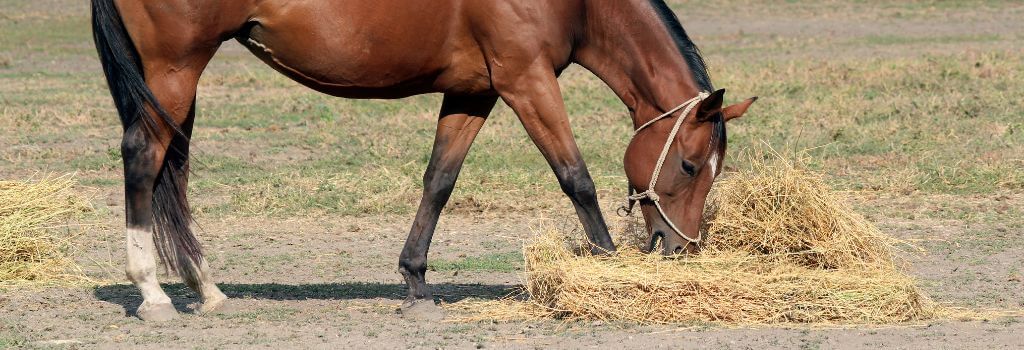Equine Metabolic Syndrome (EMS) is a complex condition that affects horses of all breeds but is especially common in ponies and easy keepers. Characterized by insulin dysregulation, abnormal fat deposits, and an increased risk of laminitis, EMS can significantly impact a horse’s quality of life if left unmanaged. While there is no cure, the right combination of diet, exercise, and veterinary care can help control symptoms and prevent complications.
In this article, we’ll walk through everything you need to know about EMS—including the warning signs, diagnostic process, treatment strategies, and practical management tips—to help keep your horse as healthy as possible.
What is Equine Metabolic Syndrome (EMS)?
Equine Metabolic Syndrome (EMS) is primarily a hormonal disorder found in overweight horses; however, lean horses can also be affected. The main concern with EMS is insulin dysregulation (ID), which occurs when insulin levels in the blood are abnormally elevated. Insulin plays a crucial role in regulating blood sugar (glucose) levels, particularly after eating. When insulin fails to function properly, it can result in significant health issues.
One of the biggest risks of EMS is laminitis—yes, you read that right! High insulin levels can actually cause laminitis, a painful and potentially life-threatening condition affecting the hooves.

What Causes EMS in Horses?
Equine Metabolic Syndrome (EMS) is a complex condition that primarily involves issues with insulin regulation, excess weight, and a heightened risk of laminitis. Several factors come together to influence the development of EMS, including genetic traits, dietary choices, and lifestyle habits.
- Genetic Factors: Some horse breeds are more susceptible to Equine Metabolic Syndrome. Interestingly, this is believed to be linked back to their unique evolutionary history that stimulates efficient energy storage. Breeds like ponies, donkeys, Arabians, and mustangs developed in areas where food was not always abundant, which means they have "thrifty" genes that allow them to make the most of available glucose. In today’s world, where food is abundant and easily accessible, these genetic traits may put these breeds at a greater risk for EMS.
- Dietary Influences: Diets high in non-structural carbohydrates (NSCs), such as grains, lush pastures, and sugary treats, can worsen insulin dysregulation in at-risk horses. Excessive intake of these high-starch feeds can lead to weight gain and subsequent abnormal insulin release and tissue insulin response. This is referred to as insulin dysregulation which is characteristic of EMS.
- Obesity and Lifestyle: Carrying excess weight can increase the chances of developing EMS. When there's too much body fat, it can lead to insulin resistance and release hormones and inflammatory substances that upset the usual metabolic functions. Living a sedentary lifestyle worsens the situation because a lack of exercise encourages weight gain which in some horses can lead to insulin dysregulation. That's why incorporating regular physical activity into your horse's routine is so important for effectively managing and preventing EMS!
Signs and Symptoms of Equine Metabolic Syndrome
The hallmark of EMS is insulin dysregulation, which means the body doesn’t handle insulin properly. Most affected horses are overweight, with a body condition score (BCS) of 6 or higher, and may have fat deposits in specific areas.
Common signs of EMS include:
- Excess body fat, especially in the neck (“cresty neck”), ribs, and tailhead
- Weight gain that is difficult to manage
- Laminitis, especially after grazing or eating high-carb feeds
- Abnormal insulin response to glucose
While EMS is often linked to obesity, not all overweight horses have EMS, and some lean horses can also have insulin dysregulation. This is why veterinary testing is necessary to confirm a diagnosis.
How is Equine Metabolic Syndrome Diagnosed?
When EMS is suspected, veterinarians rely on blood tests to measure insulin levels. The most common diagnostic test is the Baseline Insulin Test, which involves taking a blood sample after the horse has fasted for 4 to 6 hours. This test measures insulin levels at rest; however, since some horses with EMS may still show normal baseline insulin, additional testing is often necessary for a more accurate diagnosis.
The Oral Sugar Test (OST) is an assessment where the horse receives a dose of corn syrup, and insulin levels are measured 60 to 90 minutes later. This provides insight into how the horse’s body responds to sugar intake. Another option is the Insulin Tolerance Test (ITT), which evaluates how effectively the horse processes glucose after a small dose of insulin. For an even more comprehensive evaluation, veterinarians may use the Combined Glucose-Insulin Tolerance Test (CGIT). This test offers a deeper understanding of both insulin resistance and pancreatic function through intravenous infusions of glucose and insulin.
Since stress can temporarily affect glucose and insulin levels, these tests are most effective when the horse is calm and in a familiar environment. A comprehensive evaluation, along with clinical signs and risk factors such as obesity and a history of laminitis, helps veterinarians confirm EMS and create an effective management plan.
Managing Equine Metabolic Syndrome (EMS): Diet, Exercise, and Treatment
Once a horse is diagnosed with EMS, the primary treatment goal is to regulate insulin levels, promote weight loss if needed, and reduce the risk of laminitis. Effective management requires a combination of dietary adjustments, regular exercise, and, in some cases, medications or supplements.
Dietary Management for EMS Horses
When it comes to managing EMS, diet is key! It’s important to cut back on starch and sugar while making sure your horses get the nutrition they need. Limit or even avoid high-starch feeds like grains, lush pasture, and those tempting sugary treats. Instead, focus on feeding them low-starch hay, which should have less than 10% non-structural carbohydrates (NSC). Soaking hay in cold water for a minimum of an hour effectively reduces extra sugar. A ration balancer can also help horses meet their nutritional needs without piling on extra calories.
*Remember, EMS is something horses will live with long-term, meaning they can still be at risk even after reaching a healthy weight and stable insulin levels. While some horses may learn to enjoy a bit of grass or grain as time goes on, any changes to their diet should always be made with the help of a veterinarian.

Exercise and Its Role in EMS Management
Regular exercise is essential for enhancing insulin sensitivity and supporting weight loss in EMS horses. Daily activities—such as lunging, groundwork, or riding—can be beneficial if the horse is healthy and not suffering from laminitis. Turnout is also advantageous, but grass intake must be closely monitored.
*If laminitis occurs, stall rest is required until the condition is under control. Given that exercise needs differ according to the horse’s condition, it’s crucial to collaborate with a veterinarian to establish a safe and effective workout plan.
Medications and Supplements
For some horses, diet and exercise alone may not be enough to manage EMS. In these cases, veterinarians may prescribe medications to help regulate insulin levels. Levothyroxine is sometimes used temporarily to boost metabolism and encourage weight loss, while Metformin can help reduce insulin resistance, particularly in horses unable to exercise due to laminitis. There are other newer options for horses suffering from insulin dysregulation and laminitis. They are sodium glucose co-transporter 2 inhibitors which have been used in humans and now have found a role for horses with EMS.
*While many supplements claim to improve insulin sensitivity, scientific evidence supporting their effectiveness is limited. Always consult with a veterinarian before introducing any new supplements to an EMS horse’s diet.
Preventing EMS in At-Risk Horses
While you can’t always prevent Equine Metabolic Syndrome, there’s a lot you can do to reduce the risk, especially if your horse falls into a higher-risk breed. The first step? Keep an eye on their weight! A weight tape or scale can help you spot small changes before they turn into a bigger problem. When it comes to feeding, don’t just follow the grain bag’s recommendations; feed based on your horse’s actual body condition and needs to avoid unnecessary weight gain.
Pasture management is another biggie. Lush, sugary grass, especially in the spring and fall, can send insulin levels soaring, so limiting grazing time or using a muzzle can help keep things balanced. And just like us, horses benefit from regular exercise to keep their metabolism in check. Whether it’s daily turnout, riding, or groundwork, movement is key! Finally, don’t skip those vet visits because routine exams can catch early signs of metabolic issues before they become serious.
If you suspect your horse may be at risk for EMS, talk to your veterinarian about testing and developing a customized management plan. By staying proactive, you can help keep your horse healthy and thriving for years to come.
If you have questions and you'd like to reach out to us, you can call us directly at (970) 987-4757, or you can email us at [email protected]. Don't forget to follow us on social media Facebook, Instagram.
